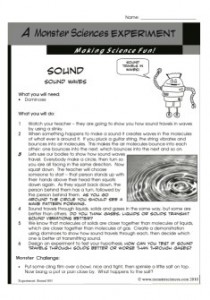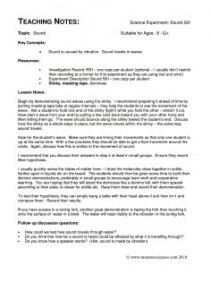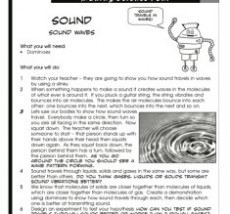A series of investigations into sound and how it travels.
 |
 |
Sound Science Experiment – Sound Waves
What you will need:
- Dominoes
What you will do:
1 Watch your teacher – they are going to show you how sound travels in waves by using a slinky.
2 When something happens to make a sound it creates waves in the molecules of what ever is around it. If you pluck a guitar string, the string vibrates and bounces into air molecules. This makes the air molecules bounce into each other: one bounces into the next, which bounces into the next and so on.
3 Lets use our bodies to show how sound waves travel: Everybody make a circle, then turn so you are all facing in the same direction. Now squat down. The teacher will choose someone to start – that person stands up with their hands above their head then squats down again. As they squat back down, the person behind them has a turn, followed by the person behind them. As you go around the circle you should see a wave pattern forming.
4 Sound travels through liquids, solids and gases in the same way, but some are better than others. Do you think gases, liquids or solids will transmit sound vibrations better?
5 We know that molecules of solids are closer together than molecules of liquids, which are closer together than molecules of gas. Create a demonstration using dominoes to show how sound travels through each, then decide which one is better at transmitting sound.
6 Design an experiment to test your hypothesis, How can you test if sound travels through solids better or worse than through gases?
Monster Challenge:
. Put some cling film over a bowl, nice and tight, then sprinkle a little salt on top, Now bang a pot or pan close by. What happens to the salt?
Teaching Notes:
Topic:
Sound
Key Concepts:
¨ Sound is caused by vibration. Sound travels in waves.
Resources:
Investigation Record IR01– one copy per student (optional – I usually don’t restrict their recording to a format for this experiment as they are using trial and error)
- Experiment Description Sound S01– one copy per student
- Slinky, masking tape, dominoes
Lesson Notes:
Begin by demonstrating sound waves using the slinky. I recommend preparing it ahead of time by putting masking tape tabs at regular intervals – they help the students to see the movement of the wave. Ask a student to hold one end of the slinky (tight!) while you hold the other – stretch it out. Now start a wave from your end by pulling a few coils back toward you with your other hand and then letting them go. The wave should bounce along the slinky toward the student’s end. Discuss how the slinky as a whole stays in place, but the wave moves within the slinky – the same way sound travels.
Now for the student’s wave. Make sure they are timing their movements so that only one student is up at the same time. With a few practices they should be able to get a fluid movement around the circle. Again, discuss how this is similar to the movement of sound.
I recommend that you discuss their answers to step 4 at least in small groups. Ensure they record their hypothesis.
I usually quickly revise the states of matter here – I draw the molecules close together in solids, further apart in liquids etc on the board. The students should then be given some time to build their domino demonstrations, preferably in small groups to encourage team work and cooperative learning. You are hoping that they will stand the dominoes like a domino fall, with them spaced according to their state, ie closer for solids etc. Have them draw and record their demonstration.
To test their hypothesis, they can simply bang a table with their head above it and then on it and compare them. Record their results.
If you have access to a tuning fork, another great demonstration is taping the fork then touching it onto the surface of water in a bowl. The water will react visibly to the vibration in the tuning fork.
Follow up discussion questions:
How could we test how sound travels through water?
- Do you think that how far a sound is heard could be affected by what it is travelling through?
- Do you know how a speaker works? (Hint, sound is made by vibration)



